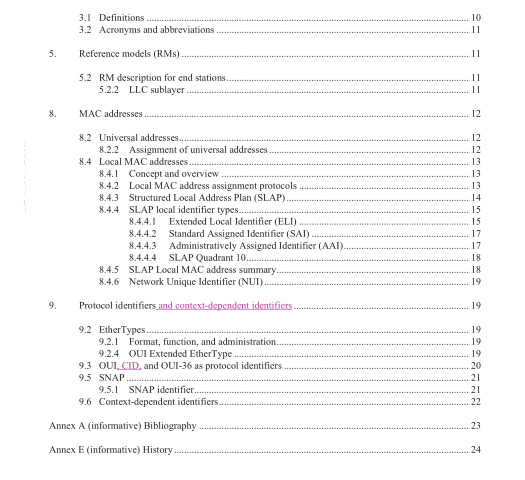IEEE 802c-2017 pdf download.IEEE Standard for Local and Metropolitan Area Networks: Overview and Architecture Amendment 2: Local Medium Access Control (MAC) Address Usage
8.4.1 Concept and overvlew
The U/L bit of a local MAC address is set to 1, indicating that the remaining bits (ic, all bits except the U/L bit and the I/G bit, which is sel as described in 8.2.2) are locally administered. Local MAC addresses are not presumed globally unique across all IEEE 802 nctworlks. The locally administered bits of loeal MAC adresses are arbitrarily ssignable under the condition that local MAC adresses are unique within a LAN (which may be a bridged LAN or virtual bridged LAN).
In a virtual bridged LAN wherein the bridges use Independent VLAN Learming. the uniqueness condition applies to cach VLAN rather than to the entire virtual bridged LAN. Any failure of such uniqueness invalidates the fundamental premises of IEEE 802 network operation and may lead to disruption.
Therefore, administrators should ensure that the probability of local MAC address non-uniqueness is acceptably small. While a local administrator may assign adresses throughout the local range, the optional Structured Local Address Plan (SLAP) specifies dffrent ssinment approuches in four specified regions of local MAC address space. Unlike universal adresses,s which are peristent to the MAC entity local MAC adresses are not nsessarily persistent. The local MAC address assigned to a MAC entity, including any subsequent change to that assignment, is entirely within the scope of the local administation.
8.4.2 Local MAC address assignment protocols An address assignment protocol assigning local MAC addresses to devices on a LAN should ensure uniqueness of those ddresses, per the description of F.1.2 of IEEE Std 802.1Q. That standard’s Annex F also identifis risks of non-uniqueness.
When multiple address assignment protocols operate on a LAN without centralized administration, address duplication is possible even if each protocol alone is designed to avoid duplication. When multiple address assignment protocols operute on a LAN without centralized administation, address duplication is possible, even if each protocol alone is designed to avoid duplication, unless such protocols assign adreses from disjoint adress pools. The subclauses below specify the usage of local MAC address space according to the SLAP. Administrators who deploy multiple protocols on a LAN in acordance with the SLAP will enable the unique assignment of local MAC adresses within the LAN as long as cach protocol maintains unique asignmnents within its own address subspace.
8.4.3 Structured Local Address Plan (SLAP)
The SLAP specifies use of local MAC address space. Under the SLAP, the use is specified dfferently in four quadrants of local MAC address space. The lcast and sccond lcast significant bits of the initial octet of a MAC address are designated the M bit and X bit, respectively. using the terminology specifed in the IEEE RA Guidelines for Use Organizationally Unique Identifier (OU) and Company ID (CID)” [Ba]. The third and fourth least significant bits of the initial octet in the local MAC address are designated the Y bit and Z bit, respectively. ilstrated for a 48-bit address in Figure 1la (sce NOTE 4 of82.2).
A local address exists in one of four SLAP quadrants, each identified by a different combination of the Y and Z bits, as indicated in Table la. That table also indicates the SLAP local identifier type specifed for each SLAP quadrant. The SLAP local identifir types are specified in 8.4.4.
NOTE 1 – The specic address used in this example is not a resenved value.
NOTE 2 – The bi-stream representation of the adresses in Figure 11a and Figure 11b show the LSB of each octet first; this corresponds to the data-communications convention for representing bit serial transmission in let to right order.
Sce also 8.6 for further discussion of bit ordering issues. 8.4.4 SLAP local identifier types 8.4.4.1 Extended Local Identifier (ELI) A SLAP identifier of type: “Extended Local” is known as an Extended Local ldentifer (ELI). ELIs fall in SLAP Quadrant 01. The x, Y, and Z bits of an ELI are I, 0, I, respectively. An ELI may be used as local MAC address; such an address is known as an ELI address.
The IEEE RA uniquely assigns a 24-bit idenifer known as the Company ID (CID) to identity a company, organization, entity, protocol, etc, as described in the IEEE RA “Guidelines for Use Organizationally Unique Idenifer (OUI) and Company ID (CID)” [Ba]. . An ELI is based on an assigned Company ID. Two difeent lengths of ELI are specified: ELI-48 is a 48-bit ELI, and ELI-64 is a 64-bit ELI, as described in Table lb.IEEE 802c pdf download.IEEE 802c-2017 pdf download
IEEE 802c-2017 pdf download

Leave a Reply